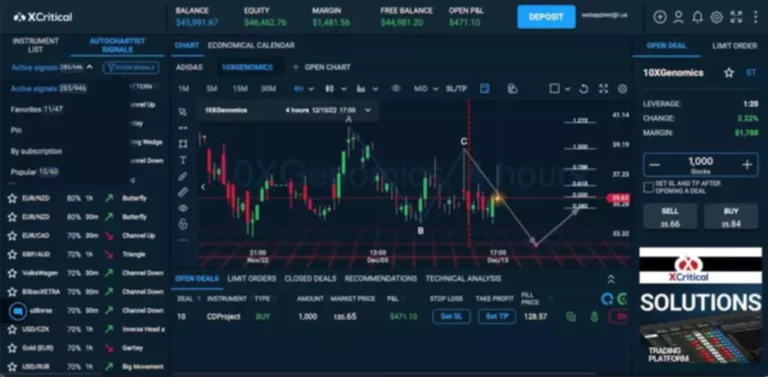Smart Contracts: Examples and Use Cases for Beginners
Content
More healthcare institutions are using blockchain to provide reliable automation and up-to-date security measures. They can also optimize transaction speed and efficiency by reducing the need for lawyers or brokers, allowing sellers to take charge of the process. Smart contracts were introduced in the 1990s by cryptographer Nick Szabo, who described them as “a set of promises, specified in how do smart contracts work digital form, including protocols within which the parties perform on these promises.” See how blockchain is solving problems for businesses and industries and get inspired.
Applications of Smart Contracts in Emerging Technology
I call these new contracts “smart”, because they are far https://www.xcritical.com/ more functional than their inanimate paper-based ancestors. A smart contract is a set of promises, specified in digital form, including protocols within which the parties perform on these promises.” Arithmetic operations, which are used to verify transactions, usually operate within a fixed range of values in smart contract execution.
Health and agricultural supply chains
Most traditional digital agreements involve Proof of personhood two parties that don’t know each other, introducing risk that either participant won’t uphold their commitments. To resolve counterparty risk, digital agreements are often hosted and executed by larger, centralized institutions like a bank that can enforce the contract’s terms. These digital contracts can be directly between a user and a large company or involve a large company acting as a trusted intermediary between two users. While this dynamic allows many contracts to exist that otherwise wouldn’t take on such risk, it also creates a situation where the larger, centralized institutions exert asymmetrical influence over the contracts. To simplify the web3 development process, Ethereum introduced Solidity, a programming language custom-built to write and implement smart contracts.
Eliminating the go-between in financial transactions
- Smart contracts could increase the traceability of products and materials and address environmental, social and governance goals at the same time.
- Internet-of-Things (IoT) enabled smart containers could send data instructing a smart contract to hold back payment.
- Sonoco and IBM are working to reduce issues in the transport of lifesaving medications by increasing supply chain transparency.
- A variety of other industries could benefit from using blockchain-based smart contracts.
- Smart contracts can speed the execution of processes that span multiple parties regardless of whether they are in alignment with all parties’ intention and understanding.
- In 2008, the bitcoin cryptocurrency was developed on a blockchain network with a distributed ledger that tracks monetary transactions.
- By enabling externally connected smart contracts, Chainlink greatly expands and enhances the valuable properties of blockchains, leading to superior, verifiable digital agreements across more industries and use cases.
Smart contracts can automate tasks such as property transfers, escrow services and title registrations. This reduces the need for intermediaries, speeds up transactions and ensures transparency in the real estate market. For example, in 2016, Cook County, Ill., used blockchain to create a database to transfer and track property titles.
Smart contracts are used to manage and enforce intellectual property rights such as copyrights and patents. The process of creating a smart contract starts with business teams working with developers to describe their requirements for the desired behavior of the smart contract in response to various events or circumstances. Simple events could be conditions such as payment authorized, shipment received or a utility meter reading threshold. A smart contract is a self-executing computer program that automatically executes the terms of a contract without the involvement of third parties. Smart contract execution can result in the exchange of money, delivery of services, unlocking of content protected by digital rights management or other types of data manipulation such as changing the name on a land title. Smart contracts can also be used to enforce privacy protection by, for example, facilitating the selective release of privacy-protected data to meet a specific request.

By automating these actions, the need for an intermediary or trust between the parties is removed. Monetary transactions require high levels of trust and transparency — especially important for companies in industries which deal with large volumes of financial transactions, like insurance. The decentralized autonomous organizations are blockchain communities that are bound to specific rules coded into blockchain contracts combined with governance mechanisms. Hence, any action taken by the community members gets replaced by a self-enforcing code.
In particular, once a smart contract is deployed, it will always function identically – it cannot be modified or taken control of by a bad actor. Smart contracts gave us the opportunity to create any kind of token without having to launch an entirely new blockchain. With the emergence of Ethereum, a token became just a piece of code — a smart contract — with certain functions including enabling the “transfer” of digital assets and the ability to “read” the account content of token holders. Smart contracts are digital transaction protocols that verify, control, and self-execute an agreement, embedded in computerized codes on a blockchain, if parties meet predefined rules. Unlike traditional (physical) ones, these contracts occur among anonymous parties and are enforced automatically without the involvement of any third party. Smart contract use cases extend beyond cryptocurrency transactions and improve numerous industries.
A well-coded smart contract can eliminate these data disparities to ensure smooth transactions while strengthening business communication. One of blockchain technology’s strengths is its use of computational logic to move data between nodes. However, hackers are finding ways to target that logic and exploit the interoperability of the software. These attacks are seen primarily in cryptocurrency, but that doesn’t mean smart contracts are immune. An unsecure, poorly coded smart contract could potentially expose an entire enterprise blockchain to threats.

When compared to traditional organizations that rely upon centralized servers for the saving of data, decentralized entities are more secure, democratic, and cost-efficient. By incorporating Szabo’s smart contracts into the Ethereum Virtual Machine (EVM), he created a blockchain network capable of storing both transactions and code (smart contracts) in its blocks. Smart contracts are complex, and their potential goes beyond the simple transfer of assets. They can execute transactions in a wide range of fields, from legal processes to insurance premiums to crowdfunding agreements to financial derivatives. Smart contracts have the potential to disintermediate the legal and financial fields by simplifying and automating routine and repetitive processes for which people currently pay banks and lawyers sizable fees. The developers then work in a smart contract-writing platform to develop the logic and test it to ensure that it works as intended.
In this blog, we’ll give you a quick overview of what smart contracts are and how they work. Then we’ll describe real-world use cases to showcase their versatility and impact across different sectors. These actions might include releasing funds to the appropriate parties, registering a vehicle, sending notifications or issuing a ticket. That means the transaction cannot be changed, and only parties who have been granted permission can see the results. Many of Szabo’s predictions in the paper came true in ways preceding blockchain technology.
Similarly, limited-edition NFTs can have fair distribution models and RPGs can support unpredictable loot drops using randomness, helping to ensure all users have a fair shot at getting rare digital assets. Many projects access randomness using Chainlink Verifiable Random Function (VRF)—a random number generator (RNG) that uses cryptography to prove it’s tamper-proof, meaning the RNG process is publicly auditable. Read on for a simple introduction to smart contracts and what they mean for society.
The blockchain network maintains a transparent, secure, and immutable transaction. They allow users to represent immutable ownership of unique digital assets and enable their secure creation, ownership and transfer. Created in 2017 on the Ethereum network, it allows users to buy and trade digital cats. The most expensive digital cat, Dragon, was sold in 2018 for approximately $170,000.
They provide an additional layer of security and trust in peer-to-peer transactions, ensuring both parties meet their obligations before funds or assets are released. There are several popular programming languages used for smart contract development. Some of the most popular include the WebAssembly (WASM) language and the Digital Asset Modeling Language (DAML). Beyond processing claims, smart contracts can improve insurance by automating policy management, underwriting, and fraud detection. They can streamline the issuance and renewal of policies, ensuring compliance with terms and reducing administrative tasks.

Storing a patient’s chart on a blockchain could potentially cut down on paperwork processing, improve regulatory compliance and simplify information sharing between providers. For example, if a patient needs a medical procedure, a prior authorization request could trigger a smart contract that reviews insurance coverage and releases payment to the provider. Smart contracts could reduce, if not eradicate, the wastage of food and medical supplies, among others. An IoT smart contract can be written to assign public keys to packages whose data would exist on distributed ledger technology, along with the package’s location and — if necessary — the medical facility that owns it. The advent of smart contracts and the token economy has opened up various sectors of the global economy in methods of transactions and ownership due to the numerous possible applications they can fulfill. Overall, smart contracts are a powerful tool for automating and streamlining a wide range of processes and transactions, making them faster, cheaper, and more secure.
All Categories
- ! Без рубрики (4)
- 1 (2)
- AI News (2)
- blog (1)
- Blogs (1,852)
- Book4all (3)
- CSR (1)
- En (1)
- FinTech (2)
- New Post (1)
- News (1)
- Scholarship (4)
- Uncategorized (1)
- Форекс Брокеры (1)


